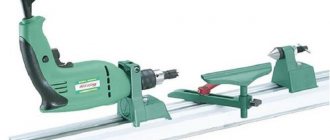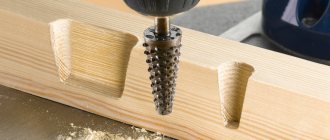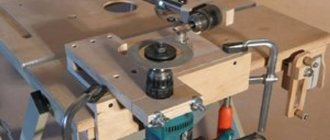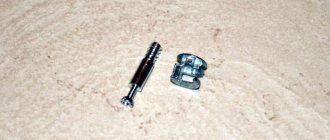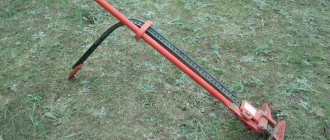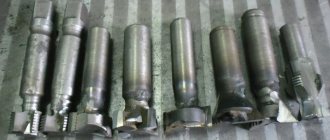The functionality of electrical appliances can be increased by connecting devices and various additional accessories. Thus, a wood cutter for a drill allows you to work with wood and cut shaped notches in timber. They achieve a high-quality level in roughing or finishing of blades by installing working attachments with an actuator.
Wood cutter for drill
Manufacturers have produced various types of cutting elements, but they need to be selected correctly; they must be suitable for working with a specific drill.
general information
The drill cutter is one of the replaceable elements. Each part in the assembly performs an important function. The motor of the electrical appliance transmits the rotation speed to the shaft, and the nozzle with accessories will rotate with it.
Milling cutter
Only the cutter processes a given area. The final result depends on the correct choice of which, combination of parameters, compliance with conditions.
How the cutting part works
Actuating mechanism
The actuator consists of 2 elements:
- shank (1) – it is clamped by a cartridge to transmit torque;
- working sphere (2) – there are sharpened blades on the sides of the head.
The configuration of the cutting edge provides different capabilities to this knife. The quality and type of sharpening are used to perform tasks of varying complexity. An additional element - a support bearing (3) - can simplify milling with a drill or expand these functions. For example, process a workpiece according to a template. If the system is dismountable, the cutter with its constituent parts regulate the work processes in the desired direction using:
- locking couplings;
- calibration bushings;
- washers;
- screws
The shank or base of the cutter comes in different lengths and diameters. These parameters are taken into account when choosing.
The chuck must hold the part tenaciously and be long enough to perform specific operations. The technical characteristics and purpose of the blade determine how much work can be done with it. It is sharpened manually and using high-precision equipment if there are no backlashes in the structural elements. In addition to sharpening, the alloy from which the item is made is also important. The hardness level of the steel must correspond to the structure being processed, in this case wood.
The standard set of cutters includes elements of different parameters and categories in the form:
- mounted, when the landing part with a diameter of 32 mm can only be installed in stationary milling equipment;
- end with a shank from 8 to 12 mm. in diameter, they are mounted on the machine shaft and on the drill.
This assembly replaces a professional milling cutter when processing:
- natural wood;
- plywood;
- chipboard;
- MDF.
When the cutting tool is going to process plywood, a knife with a high level of wear resistance is inserted. Let's say that a jigsaw with its cutting plates contains a strong alloy and is not sharpened.
Application at work
The main problem limiting the use of a drill when milling is ergonomics. The entire design of the power tool is aimed at processing the material along the axis of rotation. When milling, movements directed perpendicularly are required. In most cases, it is impossible to ensure positioning of the drill, especially when holding it with one hand. Therefore, the lot of owners of only one tool remains drilling and light types of work, such as grinding edges.
A good way out of this situation is to use special devices similar to those used in woodworking routers. Today you can find various options for drill attachments in the form of a support table, a sliding base or a vertical bed. If these are not available, it is enough to secure the electric drill to the table using clamps. After this, all that remains is to install the cutter for the drill and you can start milling.
Household electrical appliances are not designed to perform heavy-duty operations, so using a drill for metalworking is unlikely to work. In some cases, it can be used to cut sheet material or correct an edge. A much wider range of work is provided when processing wood. If high productivity is not required, then almost all types of milling operations can be performed. The same can be said about plastic work. A certain disadvantage in both cases will be the difficulty of selecting modes, since not all drills will provide the required tool rotation speed. You should also pay attention to the engine power of the power tool. In budget models, this parameter can significantly limit the diameter of the equipment used.
What do they pay attention to?
If you use a drill for milling wood, take into account a number of features:
- The operation of bearings on a shaft with the calculation of axial longitudinal load. In some types of mechanisms, a lateral force is applied, which affects the rapid wear of parts.
- Speed of revolutions.
- Cooling methods.
- Engine power.
- Handle placement.
- Cartridge quality.
Electric drill cutters
The electrical device must be equipped with a function that regulates speed with a large reserve of power - this means that cutters for an electric drill can be installed on it.
If there is incompatibility in the mechanism of devices, negative consequences are possible:
- the tool will overheat;
- the gearbox will fail;
- in the process, a distortion of the workpiece is formed;
- the shank will pop out due to an unreliable cartridge.
There are unwritten rules for milling:
- actions are performed slowly, accurately and accurately;
- check all connections, electrical wiring, fixation;
- Allow the drill to cool periodically.
When large volumes of work are to be done, a carbide nozzle is needed. Only after the equipment is securely fixed in the chuck do they begin to mill.
Choose a knife according to the following criteria:
- size - the parameter affects the assigned technological task;
- shape, configuration, location of the blades;
- sharpening angle;
- manufacturing materials - the performance of various operations and service life depend on the steel;
- purpose - if the milling drill is durable, it is used not only for wood drilling, but also for harder materials.
When buying any product, they visually evaluate it and look at the manufacturer’s company. The reputation of the enterprise will reveal the pros and cons of production. You need to do the same with the equipment. If the buyer is not rich enough to afford a cheap thing, the cutter should be of good quality and expensive.
Karnash brand tools
Today it is not difficult to choose and purchase core drills to solve any technological problem, since they are presented on the modern market with a wide variety of types and brands. These can be core drills for wood, as well as more durable and wear-resistant tools for concrete, cutters for making holes in metal products and structures.
Among specialists who often work with core drills, products manufactured under the Karnash brand are popular. The popularity of these core drills is facilitated not only by their exceptionally high quality, but also by the fact that they are available in a wide range, from which you can choose a tool to solve a specific task.
Karnash core drills
Thus, among the products manufactured under this brand, we can distinguish core drills of the following series:
- Gold-Line, made of high-speed steel HSS-XE, on the surface of which a wear-resistant coating is applied using Gold-Tech technology;
- Hard-Line, the cutting part of which is made of Swedish-made carbide inserts (the expanding spiral groove of core drills in this series simplifies the removal of chips from the processing zone);
- Rail-Line, the working part of which is also equipped with carbide inserts with multi-stage sharpening of cutting edges (with the help of tools in this series, railway rails are drilled);
- Blue-Line and Blue-Line Pro, used for drilling hardened railway rails, cast iron, aluminum and stainless steel.
Design Features
The cutting device is based on the teeth around its body and the manufacturing technology of the structure itself:
- solid - made of one metal composition;
- combined - with knives made of one hard alloy and a body made of another metal;
- welded, when the shank is connected to the blades by welding;
- soldered - the assembly is fixed by soldering.
The blades can be pointed with a front and back flat surface. The disadvantage of such items is that they are sharpened; they shrink in size, so they are not suitable for reusable use. Unlike backed bits, which can be resharpened. On the front side they are flat, and on the back they are twisted like an Archimedean spiral. Such a profile is obtained by uniform movements - translational and rotational. The backing procedure is performed with cams, which creates a stable back angle along the entire length. A similar design is created for cutters:
- shaped;
- worm;
- modular.
Cylindrical peeling knife
The mounted cylindrical peeling knife has separation grooves for chips.
They are directed in one direction, and the backed tooth is directed in the opposite direction. Blades placed in different directions allow high-quality processing of side walls. They are pressed into the body, where the radial corrugations move. After sharpening, the dimensions of the actuator do not change.
Design and principle of operation of the tool
Of all types of metal working tools, milling cutters represent the largest and most diverse group. Their design and operating principle differs from all other cutters and drills. The tool mounted on the spindle rotates. The part moves relative to it translationally along three axes and at an angle in any direction. Sharp edges and blades remove chips. As a result, on the workpiece:
- planes are processed;
- the ends are cleaned and shaped;
- keyways are cut;
- slits are made;
- rolled parts and parts are cut off;
- chamfers are removed;
- teeth and splines are cut;
- T-shaped and figured grooves are made;
- holes are drilled and bored.
The cutter is a multi-cutting tool and consists of a body on which the cutting edges are located. There is a conical or cylindrical shank for mounting into the chuck. The part is fastened to the mandrel with washers, sliding the groove onto the protrusion for rotation. It can have insert plates and cutting edges sharpened from a single piece for metal milling.
Basic actions and their order
Wood is a soft raw material. Different types of cutting tools have been developed for its processing. When choosing equipment you need to consider:
- The wood cutting knife should not be used for grinding or cutting metal structures.
- The drill for metals is made of strong high-alloy compounds that cannot negatively affect the operation with chipboard. There will be no overheating of the motor and gearbox. The end blade has this design; it is used to cut sheet material, and small-sized groove milling is performed. Although such models are endowed with a small number of feathers.
Groove cutter with different geometries, convenient for creating long grooves. And shaped cutters are used only for tortuous, complex design configurations.
Edge knife
The edge knife itself speaks about its purpose; it is good for sanding the sides. A bearing is installed at the end of such blades; it regulates the direction and prevents it from moving away from the formation of the edge. Finishing is performed on both straight and shaped edges.
Repairs to wooden buildings are not complete without sealing old holes and cutting out new ones.
Actuator of different designs
This requires a drill, and to perform several tasks you will need a whole set.
Where each tool has its own dimensions in diameter and length. They have the peculiarity of changing proportionally. When one value increases or decreases, another indicator changes in the same direction. There are no thin and long elements; they will simply break under a slight load. For example, at 12 mm. diameter, the length will be a drill bit for a drill of 50 mm., There are also 60 mm. These devices are also different in appearance:
- spiral;
- screw;
- feathers;
- ring;
- countersinks;
- flexible.
Through space can be created, different in geometric shape:
- cylindrical;
- conical;
- stepped;
- square.
The mechanism for wood processing, unlike metal processing, has a conical end; it is used to mark the drilling location.
Selection options
When choosing one or another method of milling wood, first of all you should pay attention to the possibility of installing a milling attachment on a drill. To do this, the power tool must have a cylindrical neck, in the extension of which a chuck is installed. In the absence of one, it is not recommended to use a specific drill model for milling. If it is installed on a specialized drill device intended for milling, then you can select cutters. First of all, you should pay attention to the type of work. The milling tool is not universal, so each operation will require its own model of equipment. The diameter of the shank must allow clamping in a specific drill chuck. It is not recommended to use large cutters, as they can require significant spindle power.
It is also necessary to take into account processing modes. Many wood tools require high RPMs that are unattainable with drills. It should be remembered that any electric drill is not designed for long-term loads. Therefore, it is not recommended to apply great effort to it and perform work continuously for a long time.
How to prepare a drill for milling
Electric drill
It may not be possible to open a full-fledged carpentry business with an electric drill, but in a home workshop, various milling procedures are often simply necessary.
Reconstruction begins from the place where the electric motor will be mounted.
If you don’t have an old table, you can put it together from available materials - boards, plywood. Bars are suitable for support legs. A recess is made on the countertop for installing the device with guides. You will need to cut a semicircular groove with a saw and drill through the circles to attach the support sheet.
After building the table you will need:
- electrical appliance;
- small cutter for testing;
- cartridge;
- chipboard sheets.
The drill is secured with clamps to a chipboard stand. The cutter is installed on the shaft. The elevator will be the carriage of the power tool with the main body. The stand and the limiting platform are connected at a right angle. The knife should extend beyond the base.
Edge sharpening
The set of equipment is not thrown away after long use; if corrected, they retain their normal condition. This is how a shaped end mill is sharpened along the front cutting edge with a diamond stone. It is attached to the table and the blade is moved along it. The sharpener is moistened with soapy water. The pointed areas will gradually recover with minimal loss in diameter.
If there is a guide bearing, remove it first, then start sharpening. Before work, first clean the cutter with a solvent to remove any remaining wood resins. The sharpening stone is chosen of the correct shape according to the level of grain. It depends on the thickness of the layer being removed and the degree of surface grinding.
They sharpen each tooth in turn, maintaining symmetry with the same number of movements, pressures - in the same direction. For soft cutters, use ordinary sandpaper, abrasive paper, which is glued to a steel or wooden strip.
Grinder
If you have a sharpening machine, then manual work can be replaced with mechanical work. The tip is restored to its former state all around, material is used for it:
- white or normal electrocorundum;
- elbor;
- green silicon carbide.
The machine can sharpen even the most complex spiral tooth shapes using rotational and translational movements. The cutter, during its longitudinal movement towards the circle, makes synchronized turns along the axis. The position of the edge does not change in height, and contact with the abrasive is maintained along with the sharpening angle.
At the end of the procedure, a control inspection of the blade is made for chips and cracks. A special device is used to determine the deformation for runout and the absence of changes in the angles. A deviation of 1 degree is allowed. Good care and correct editing will extend the life of cutters and main power tools.
Summary
Article Name
Wood cutter
Description
Wood cutter for drill 35 mm, 50 mm, 100 mm. Wood end mill for drill. Do-it-yourself wood cutter from a drill.
Author
Sarychev Alexander Viktorovich - forensic construction and technical expert, candidate of technical sciences
Publisher Name
Wikipedia of construction tools
Publisher Logo
- Related Posts
- Do-it-yourself drilling machine from a drill - detailed instructions, drawings
- Metal brush for a drill - review, how to choose
- Drill: design, types, how to choose, repair and use? The best electric drills of 2022
« Previous entry
Types of metal cutters for drills
There are several types of metal cutters that can be installed on an electric drill.
- End The most popular type of products with a vertical axis of rotation. Suitable for turning flat surfaces and removing metal of the required thickness.
Photo #3: End mills
- Disk. The cutting teeth are located both on the sides and at the end. Products are intended for cutting grooves and grooves.
- Cylindrical. Straight or helical cutting edges on the tool are located on the side. The greatest precision and accuracy of work can be achieved with nozzles with screw teeth. The axis of rotation is in the horizontal plane. Scope of application: processing of smooth surfaces.
Image #1: Cylindrical cutters
- End They have main cutting edges on the side of the cutter and auxiliary edges on the end. Suitable for cutting grooves, ledges, recesses.
- Shaped. Designed for processing shaped products.
Photo #4: Shaping cutters
- Angular. They have a complex design. There are single-angle (with cutting edges on the side conical part and end) and two-angle (with edges on adjacent conical parts). Used for processing inclined planes and corner-type grooves.


